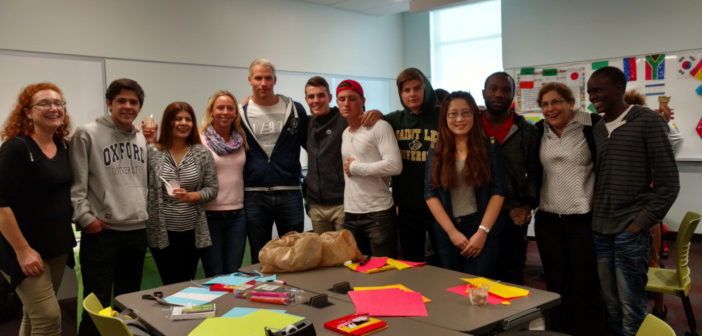Saint Leo Bridge Program Celebrates 5 years
[tribulant_slideshow gallery_id=”187″]The Bridge Program has come a long way since it started five years ago in 2012.
The academic program was put in place to help international students whose native language is not English, transition into the United States’ college environment. The program is open to students who are just below the general requirements for the English proficiency, according to the Saint Leo catalog. The program was started to offer these students extra assistance.
“In 2012, it was recognized that some of the international students need additional support during their first year of studies because of their English language proficiency and academic preparedness level. The students who qualify for Bridge [Program] receive English for academic purposes instruction, aiming to support their language development and adaptation to the new academic culture,” said Dr. Iona Sarieva, the director of the Bridge Program and assistant professor.
Sarieva confirmed that “the selection is made based on student’s language proficiency scores they submit as part of their admission application.” This allows the program to assist them to adjust in this academic environment.
The initial group of students in the Bridge Program came from Saudi Arabia.
“When the program started, the challenge was that all students came from the same country and they spoke more often their native language than English,” said Sarieva. “Today we have students from a variety of countries, and they are well-supported by the Bridge faculty members and former Bridge students in the process of their integration into the University community.”
In fact, the program has expanded to more than 20 countries, from five continents including Europe, Asia, Africa, Central America, and South America, according to Spirit, a Saint Leo publication. According to Sarieva, this semester there are 14 students in the program. She stated that this is smaller than in the beginning; however, the small class sizes allow for individual attention.
“Our today’s goals and challenges in the program are related to refining our reporting of student learning outcomes,” said Sarieva.
The program has courses that the students have to take to assist in their academic development. According to the Saint Leo website, the classes are designed to provide opportunities for the students to master their communication skills, improve learning skills and adapt to the learning culture in the United States.
Sarieva mentioned that a common challenge for students in the program is lack of adequate academic language skills. However, Sarieva also stated that after students complete the program, one benefit is that they are academically prepared, in terms of culture and language. In fact, students from this program tend to outperform other students on average, according to Sareiva.
“While some of the students may initially find their mainstream classes challenging, they perform well – among Saint Leo’s class of 2017, there were several former Bridge students who graduated with distinction – cum laude or summa cum laude. “The student speaker at our Spring 2017 commencement ceremony was Ammar Mohrat – a former Bridge student,” said Sarieva. “The attrition among the Bridge students is very low; the average GPA of the former Bridge students is typically slightly higher than the GPA of the mainstream students on University Campus.”
There are two tracks for students in the program to take: the regular track and the fast track. In 2014, the curriculum was revised to offer two tracks. The regular path has eight courses that are covered over the span of two semesters. Students with higher levels on proficiency test scores, who are considered to have advanced-intermediate performance levels, can follow the “fast track.” This track is a modified curriculum that has four classes over the course of one semester. All students start taking their first University Explorations courses while in the program as well.
“Initially, all Bridge students took the full two-semester Bridge curriculum. It was recognized that the students who are admitted through the Program typically are of two different language proficiency levels – intermediate and advanced intermediate. Based on observations, GPA data analysis, and previous research in the field of second language learning, a decision was made to offer accelerated one-semester curriculum to the advanced intermediate students,” said Sarieva.
Students do have the opportunity to opt out of some of the courses in the Bridge program, as they can challenge their level placement, but they have to follow specific steps to do so.
These courses take the place of some University courses. In fact, depending on the track taken, students “can earn up to 26 university-level elective, academic, and 6 University Explorations (general education) credits while studying in the program,” according to Saint Leo.
Along with these additional courses, the students are advised by the program director, Sarieva. Besides Sarieva, there are two other full-time faculty members, Nataliya Glover and Dr. Marcel van Olphen.
Since 2012, the Bridge Program has grown with a more diverse student population and now offers more than one track for students to follow. The program was able to help nearly 200 students and will continue to help international students maximize their opportunities for academic success.





